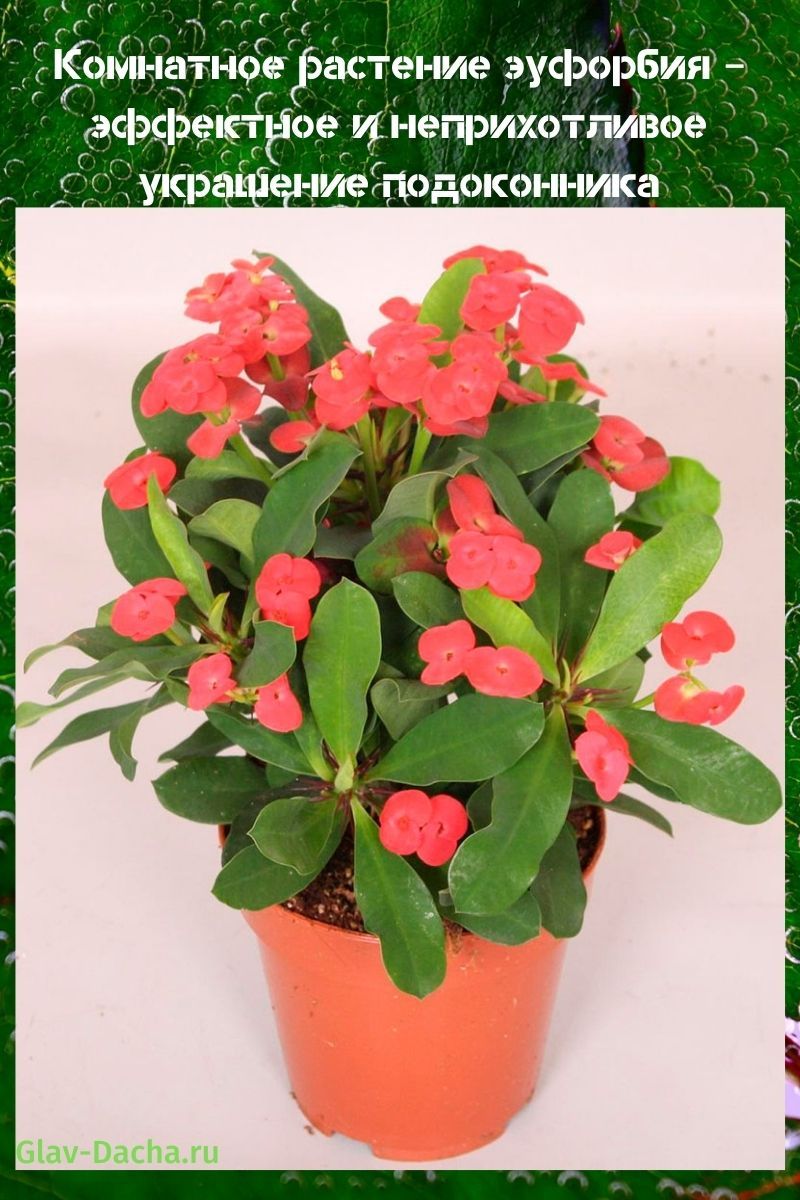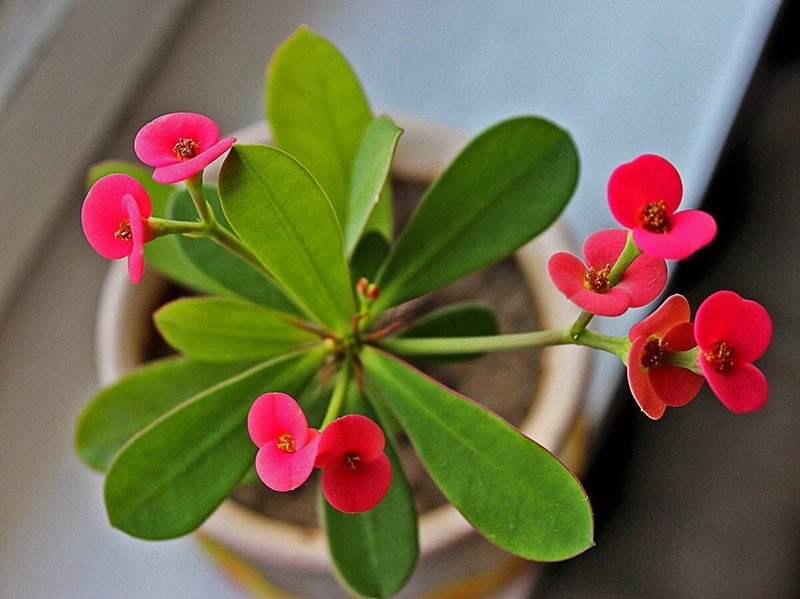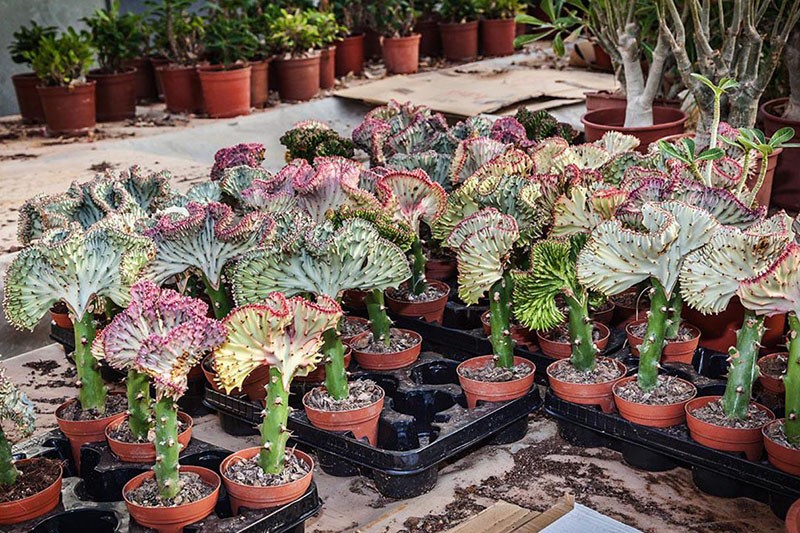Indoor plant euphorbia - a spectacular and unpretentious window sill decoration
 The houseplant euphorbia is well known to lovers of outwardly attractive and unpretentious garden and ornamental crops. It is distinguished by a huge variety of species, numbering more than 2000 varieties found in all parts of the world - from the temperate climatic zones of Europe to the tropics of Africa and the subtropics of Asia. Due to its spectacular appearance and unpretentious care, euphorbia is widely used in landscape design - for landscaping a garden plot and decorating a home.
The houseplant euphorbia is well known to lovers of outwardly attractive and unpretentious garden and ornamental crops. It is distinguished by a huge variety of species, numbering more than 2000 varieties found in all parts of the world - from the temperate climatic zones of Europe to the tropics of Africa and the subtropics of Asia. Due to its spectacular appearance and unpretentious care, euphorbia is widely used in landscape design - for landscaping a garden plot and decorating a home.
Common types of euphorbia

Common types of euphorbia:
- Kristata is a variety native to the Asian tropics. It has a tendency to constant mutations, so the appearance of the plant is diverse. Most often, its shape resembles a coral. Cristata rarely blooms.

- Marginata - also called "mountain snow". An annual plant with a height of 70-80 cm, with dense foliage of a greenish-silvery shade. During the flowering period, a silvery-white border appears on the leaves. Marginata is valued for its crown, its flowering is inconspicuous.

- Decari is a miniature succulent native to Madagascar. The main feature is wavy leaves with zigzag edges. The stem is large and thick, with a leafy rosette at the crown, the foliage is green with a slight red tint. Dekari has pretty bell-shaped inflorescences of a creamy beige color.

- Euphorbia Obesa - This variety is also called fat milkweed. Outwardly, the perennial plant resembles a small cactus - it has a spherical shape of a greenish-brown hue. It is a flower that spits seeds. At the moment of ripening, the fruit bursts, and its seeds fly around.

- Gabizan is a type of euphorbia grown only indoors. The plant reaches 25-35 cm in height, resembles a pineapple in shape with a green "tuft" on the top. As it matures, its trunk becomes woody and takes on a brown tint.

Most euphorbia are similar to cactus - they have a thickened stem and small, almost invisible leaves that help the plant to accumulate and retain moisture.
A common feature of all types of milkweed is the content of toxic milky juice. It can cause redness or allergic irritation to the skin, so you only need to wear protective gloves when working with the euphorbia houseplant.
Indoor plant euphorbia - care rules
 The peculiarities of caring for a houseplant euphorbia depends on its type. But most varieties of milkweed are absolutely unpretentious and do not require much effort. This plant tolerates even prolonged drought well, and thanks to the poisonous sap, it is almost never exposed to diseases and attacks of insect pests.
The peculiarities of caring for a houseplant euphorbia depends on its type. But most varieties of milkweed are absolutely unpretentious and do not require much effort. This plant tolerates even prolonged drought well, and thanks to the poisonous sap, it is almost never exposed to diseases and attacks of insect pests.
 Caring for the milkweed euphorbia at home is reduced to standard agrotechnical measures - timely watering, top dressing, as well as pruning. For the full development and lush flowering of euphorbia, it is necessary to provide it with an optimal microclimate that combines the correct humidity and air temperature, as well as lighting.
Caring for the milkweed euphorbia at home is reduced to standard agrotechnical measures - timely watering, top dressing, as well as pruning. For the full development and lush flowering of euphorbia, it is necessary to provide it with an optimal microclimate that combines the correct humidity and air temperature, as well as lighting.
Temperature and humidity
 The euphorbia flower tolerates temperature changes well, but when caring for it, you need to ensure that the temperature in the room does not drop below + 13 ° C in winter. During the summer months, the flower pot can be taken out on the open balcony, in the garden or on the terrace.
The euphorbia flower tolerates temperature changes well, but when caring for it, you need to ensure that the temperature in the room does not drop below + 13 ° C in winter. During the summer months, the flower pot can be taken out on the open balcony, in the garden or on the terrace.
When growing euphorbia, it is very important to choose the right place for the flower pot. It should be sheltered from cold and drafts that the plant cannot tolerate.
 Euphorbia does not have special requirements for air humidity and does not need additional humidification. If desired, you can periodically spray its leaves on summer days, removing dust and moisturizing.
Euphorbia does not have special requirements for air humidity and does not need additional humidification. If desired, you can periodically spray its leaves on summer days, removing dust and moisturizing.
Lighting
 Caring for euphorbia at home is to create the right lighting, since euphorbia is a light-loving plant. It is best to place the flowerpot on a well-lit windowsill facing south or southwest.
Caring for euphorbia at home is to create the right lighting, since euphorbia is a light-loving plant. It is best to place the flowerpot on a well-lit windowsill facing south or southwest.
 In winter, before the onset of the dormant period, and also immediately after its completion, euphorbia needs additional lighting... With a minimum of light, the growth of milkweed practically stops, its stems become thin, begin to stretch, and the leaves wither.
In winter, before the onset of the dormant period, and also immediately after its completion, euphorbia needs additional lighting... With a minimum of light, the growth of milkweed practically stops, its stems become thin, begin to stretch, and the leaves wither.
The optimal daylight hours for euphorbia are 10-11 hours. For additional illumination, special phyto-lamps are used.
Watering
 The frequency of watering euphorbia depends on several factors - weather conditions, plant age and indoor air humidity. In the spring, it is enough to moisten the milkweed once every 2 weeks using settled water at room temperature.
The frequency of watering euphorbia depends on several factors - weather conditions, plant age and indoor air humidity. In the spring, it is enough to moisten the milkweed once every 2 weeks using settled water at room temperature.
On hot summer days, the frequency of watering should be increased to 1 time per week. Moistening should be plentiful, the soil in a flower pot should not be allowed to dry out too much. In winter, the spurge is at rest, so it is moistened no more than 1 time in 4 weeks.
During watering, you need to ensure that there is no stagnation of moisture in the pot or pallet. This is one of the most common reasons why milkweed leaves dropped, as stagnant water leads to rotting of the root system. Some plant varieties completely shed their foliage in such cases.
Top dressing
 Euphorbia is unpretentious in care and needs feeding only in the phase of active growth. During this period, it is best to feed the euphorbia with complex mineral fertilizers intended for succulents and cacti.
Euphorbia is unpretentious in care and needs feeding only in the phase of active growth. During this period, it is best to feed the euphorbia with complex mineral fertilizers intended for succulents and cacti.
It is advisable to apply top dressing no more than once every 4-8 weeks - it depends on the age of euphorbia. The older the plant, the less fertilizer it needs. During the winter months, when the houseplant is dormant, no top dressing is needed.
Reproduction methods
 Most often, euphorbia is propagated by cuttings or dividing the bush. The seed method is used much less often, since the seeds very quickly lose their germination.
Most often, euphorbia is propagated by cuttings or dividing the bush. The seed method is used much less often, since the seeds very quickly lose their germination.
For propagation of milkweed, side shoots are separated or the top of the plant is cut off. The cut off part must be left to dry - milky juice should cease to stand out on its cut. After that, the stalk should be deepened 2-3 cm into the nutrient soil and covered with a cut plastic bottle or glass jar.
 When grafted, young shoots take root in 15-25 days. The protective cap must be removed every day for ventilation. The soil should not be allowed to dry out; it should be moistened with a spray bottle.
When grafted, young shoots take root in 15-25 days. The protective cap must be removed every day for ventilation. The soil should not be allowed to dry out; it should be moistened with a spray bottle.
When propagating by dividing the bush, you need to divide the adult plant, along with the root system, into several parts. Each of the resulting fragments should be planted in a separate container, not forgetting to pour a drainage layer on the bottom of the pot.
 Euphorbia is a cute indoor plant that is loved by flower growers. Its popularity is due to its spectacular appearance, minimal care requirements and excellent resistance to diseases and pests.
Euphorbia is a cute indoor plant that is loved by flower growers. Its popularity is due to its spectacular appearance, minimal care requirements and excellent resistance to diseases and pests.